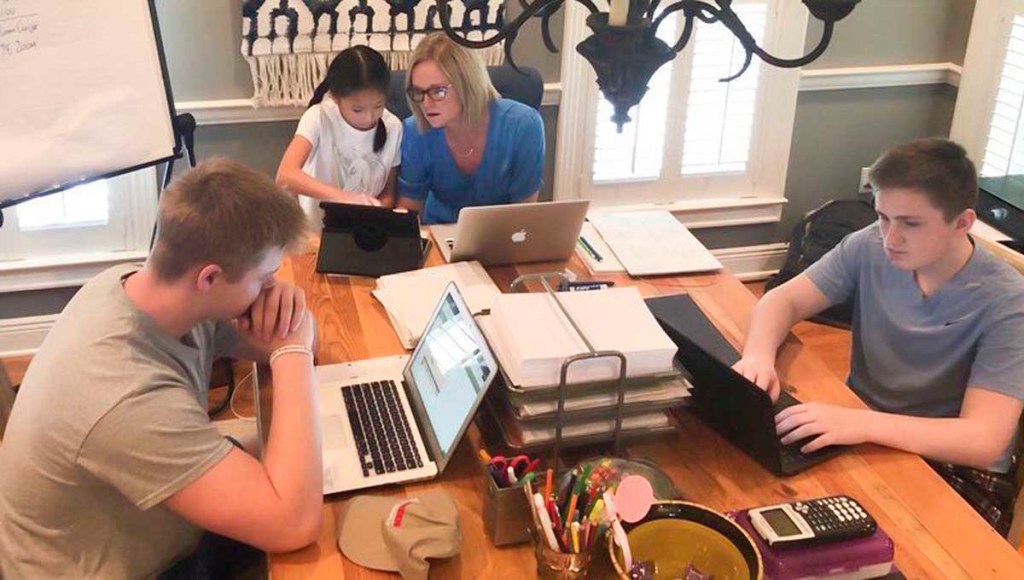Meridian area parents, teachers weigh the pros and cons of distance learning
Published 1:00 pm Monday, April 13, 2020

- Submitted photo The Ransier family does their school work at home: From left, Thad Ransier, Vivi Ransier, Jamie Ransier and Cooper Ransier. Jamie Ransier is also an English teacher at Lamar School.
Raven Lott had always considered homeschooling her children.
Now that schools are temporarily closed during the COVID-19 pandemic, the mother of seven is getting that opportunity.
Trending
“I always wanted to homeschool, but I never thought I could,” she said.
Since schools shut down in mid-March, Lott has been adjusting to distance learning with help from her children’s teachers.
The biggest advantage, Lott said, is that she’s able to work around her own schedule, teaching her kids Tuesday through Thursday. On Mondays, she gives them a break from their school work and teaches them about the Bible instead.
There are other advantages to teaching her kids at home, she said.
“It’s given me more time to care for my children,” she said.
Some issues she sees with distance learning are access to the internet, getting children to pay attention, or parents not understanding the material or being available to teach their kids.
Trending
Lott, who is president of Crestwood Elementary’s Parent Teacher Organization, meets with other parents who might need help in teaching their children or understanding the material given away.
A look at the numbers
All public schools in Mississippi are closed through April 17, and Gov. Tate Reeves is expected to make an announcement on any possible extended closures on Tuesday, April 14.
After schools were closed in March, the Meridian Public and Lauderdale County School districts started sending out surveys to determine their students’ distance learning needs.
The surveys asked if there was internet access, and if so, was it through a smartphone, computer or another device. The surveys also asked about the reliability of the family’s internet access.
In the Meridian Public School District, 90 percent of the students have access to the internet in some form, through a computer, smartphone or gaming system. In addition to offering online learning, the district is also sent out packets of printed material.
Melody Craft, director of secondary education for the district, said 437 packets were mailed or delivered to students, and the response from parents has been positive.
When the schools were closed, guidelines were loosened, allowing teachers to be flexible with how they grade. That means students won’t be penalized for not completing or turning in their work, according to Craft.
“We can’t penalize students for work they can’t complete,” she said.
Trent Airhart, technology director for Lauderdale County Schools, said its survey responses indicated that 91 percent of respondents have internet access, and 90 percent have internet access via an electronic device like a computer or tablet. Ninety-eight percent of those who responded have a smartphone.
But for many parents, reliable internet service is a problem. About 29 percent of those who responded to the survey said they didn’t have reliable access.
With that in mind, the district is sending home printed material to parents.
Airhart said the district is currently in a pilot program using the online learning platform Canvas, and teachers have the option of using resources such as Google Classroom.
Creating a bond
Leslie White, whose daughters Caree and Anley attend Southeast Elementary, said she’s been adjusting to teaching them at home, with a lot of support from their teachers.
“The teachers have made themselves readily available for any needs we have,” she said.
When her daughters received their packets, it gave them a sense of security, she said.
“Each of my kids was excited to receive a packet of stuff, it was almost like getting a present,” she said. “They were eager to work on it.”
The White family is also staying connected with teachers through the online platform Zoom. One teacher, Stephanie Mabry, held a session last week.
“It was kind of bittersweet to watch because all the kids were so excited to see each other and see Mrs. Mabry,” White said. “It kind of makes you realize how much they are missing their school, and how much they are missing their teacher and their friends.”
Mabry, for her part, misses her students as well, as she’s been adjusting to virtual learning the last few weeks.
“I think you need that bond with your teacher,” Mabry said. “You want that child to be safe and asking you questions and saying ‘hey I don’t understand this.’ It is a hard thing to get through with them if you are not with them.”
But the online sessions are keeping them connected, she said.
“It was so awesome to see the excitement, they were squealing and giggling, talking to each other because they miss each other,” she said.
As an educator, Mabry said the upside of distance learning is that it’s forcing her to be creative think outside the box. The downside is she’s not physically there to help her students, especially those who are struggling.
“It’s a lot easier for me to answer that child’s question than their parents,” she said.
Jamie Ransier, who teaches English at Lamar School, has taken on a dual role the past few weeks.
Not only is she working with her students online, she’s helping her four children at home with their classwork.
While teaching her children, she creates lesson plans, grades assignments, and records Zoom lessons for her students.
Maintaining that balance is difficult, but her family has adjusted, she said.
“I wouldn’t say the Ransiers are ‘rocking it,’ but we are staying afloat,” she said. “We still all like each other. It’s a team effort from all directions.”
Ransier listed the benefits of learning at home as having a set schedule and using technology to keep up with her students.
Like other teachers and parents, she noted several downsides: she misses her students, technology isn’t always reliable, and her students have to stay self-motivated.





